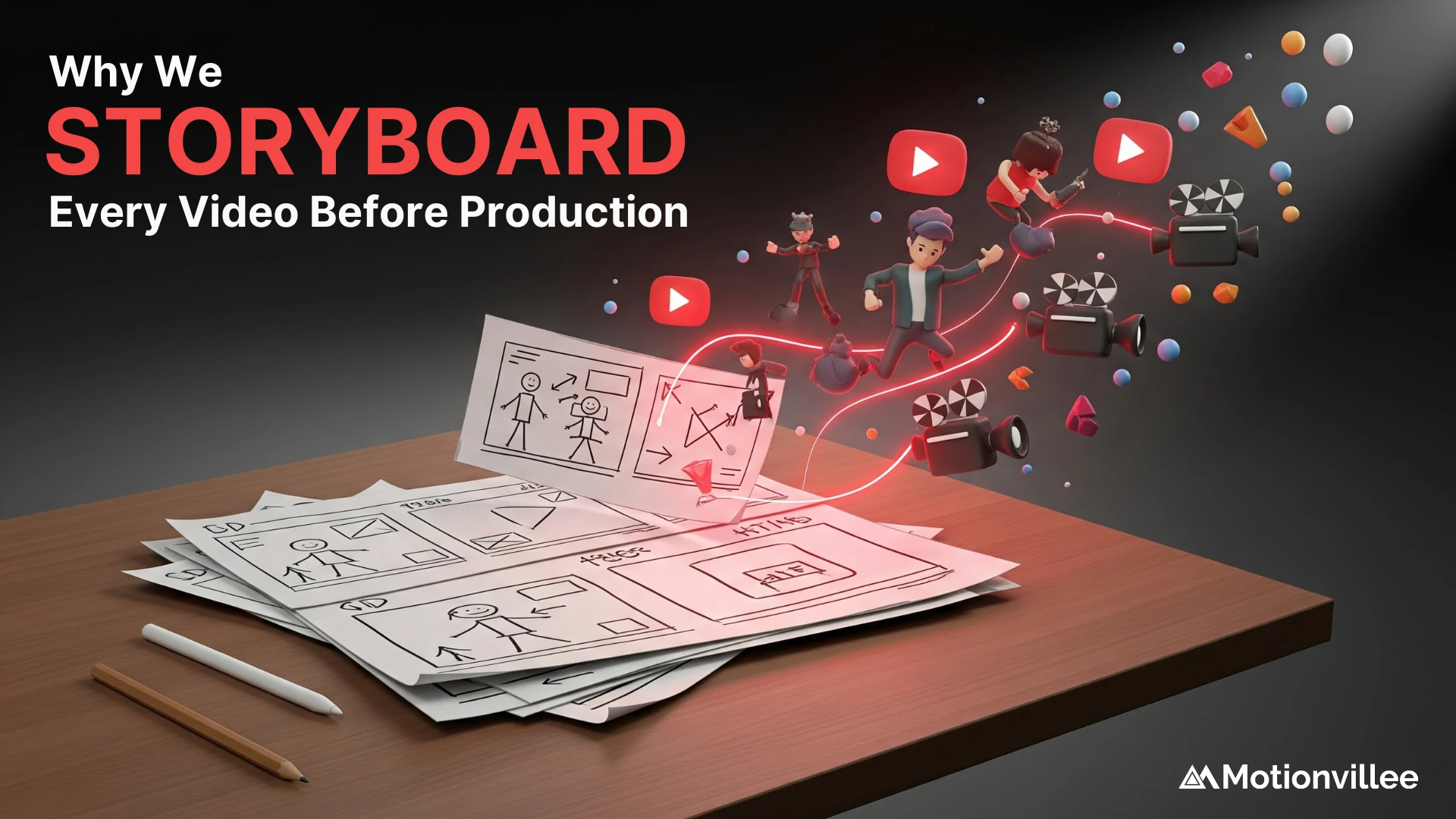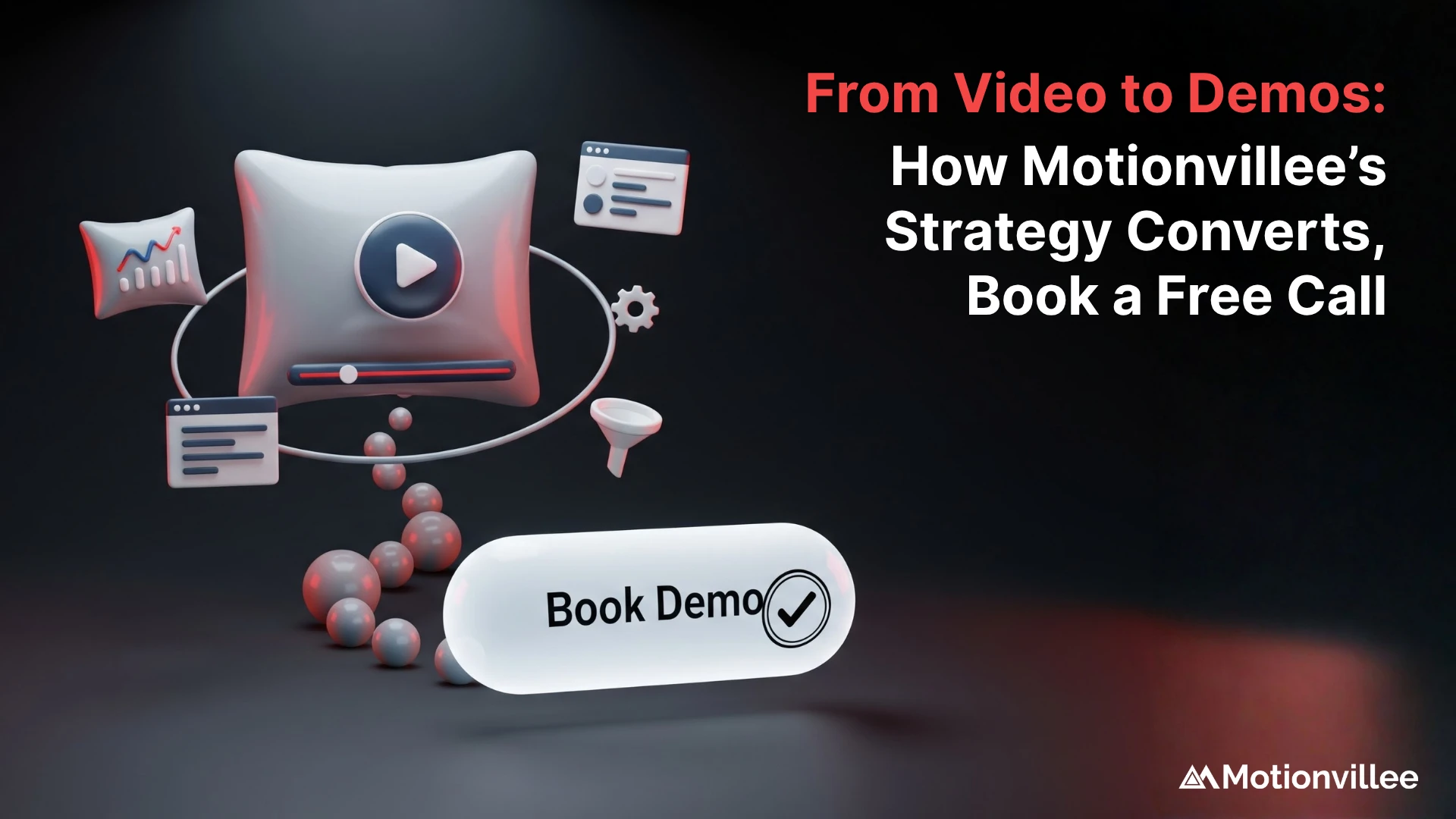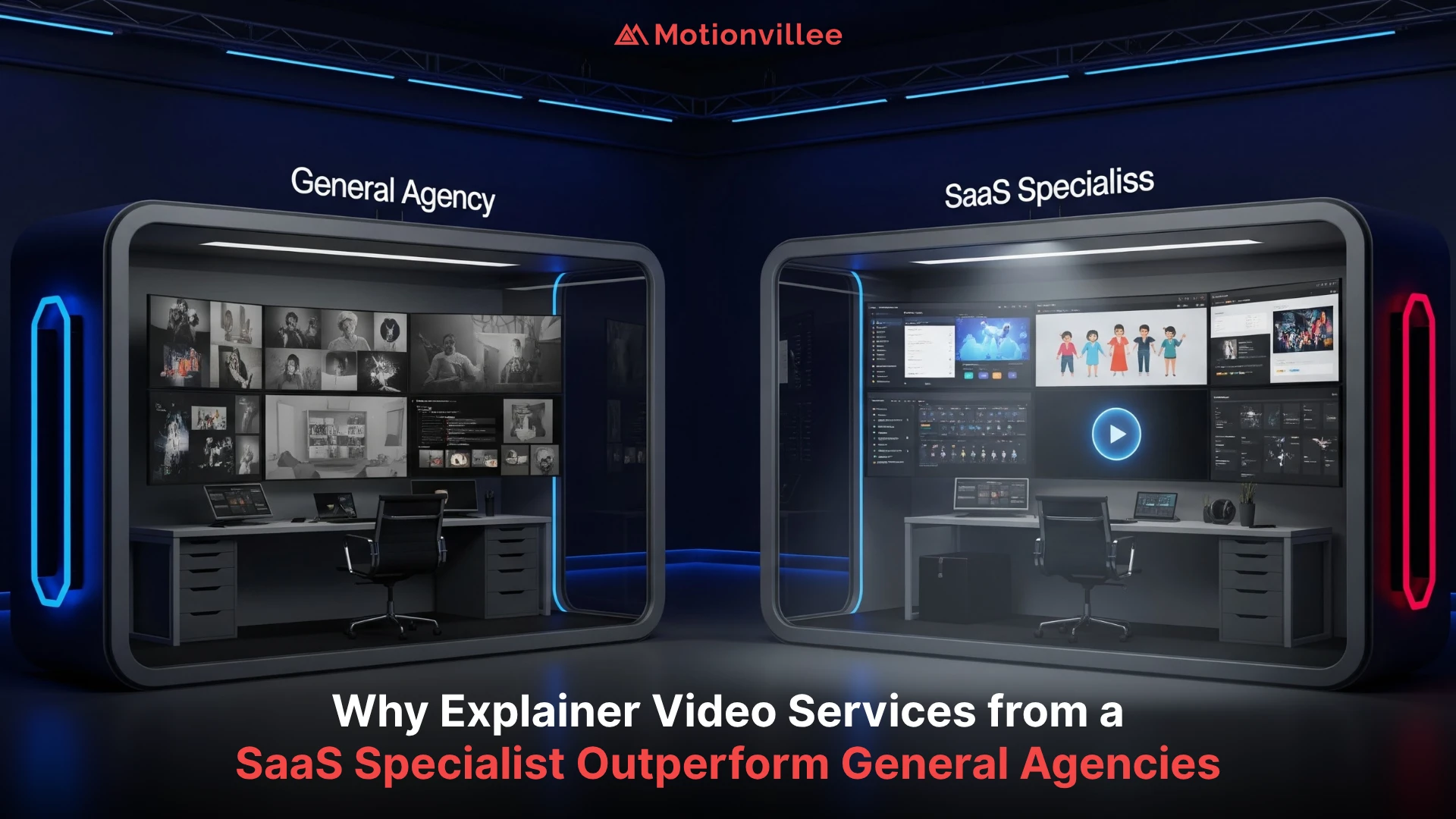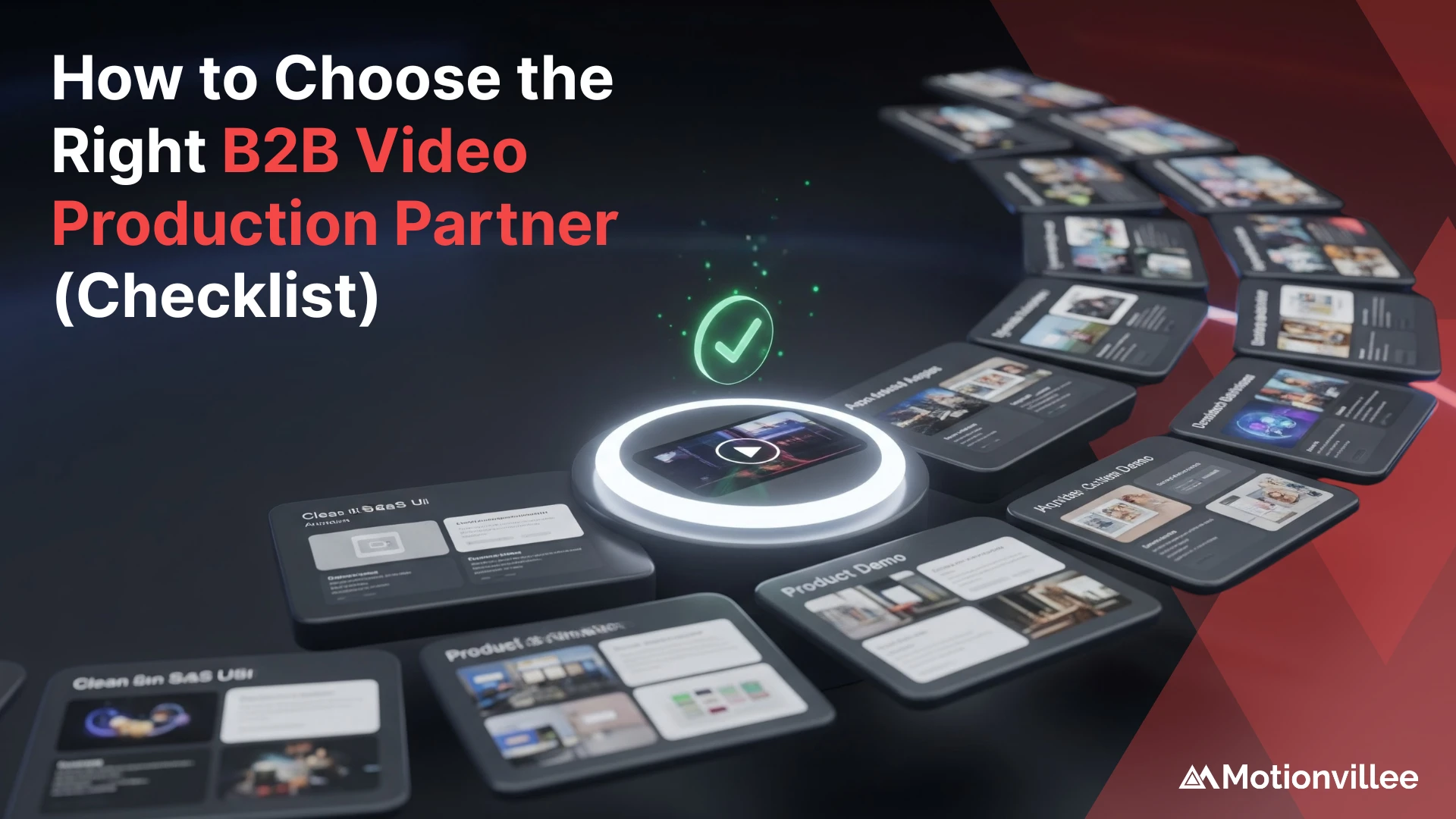The Planning Step Most Clients Skip (And Why That’s a Mistake)
You’re ready to produce your next video. Budget approved, timeline set, script finalized. Then your production company mentions storyboarding, and it feels like an unnecessary delay. Why spend extra time drawing pictures when you could just start filming?
Here’s the truth about storyboard video production. Skipping this step doesn’t save time or money. It costs you both, plus quality, clarity, and control over the final product. Companies that understand why use storyboards for video consistently deliver better results, hit deadlines, and stay on budget.
Storyboarding isn’t a creative luxury or an optional add-on. It’s a strategic tool that protects your investment and ensures your video production achieves your business goals. When you understand what happens behind the scenes during video production, the value becomes impossible to ignore.
Here’s why professional production companies storyboard every project, and why you should insist on it too.
What Is a Storyboard in Video Production?
A storyboard is a visual blueprint that maps out every scene, shot, and transition before filming begins.
Think of it as the architectural plan for your video. Just as you wouldn’t build a building without blueprints, professional video production shouldn’t start without a clear visual roadmap. A storyboard shows exactly what will appear on screen, how long each shot lasts, and how scenes connect to tell your story.
What information does a storyboard contain?
- Visual sketches of each scene or key frame
- Shot types (close up, wide shot, over the shoulder)
- Camera movements and angles
- Timing notes for pacing and transitions
- Audio cues including voiceover, music, and sound effects
- On screen text or graphics placement
A storyboard differs from a script or shot list in important ways. A script focuses on dialogue and narration. A shot list is a checklist of what to capture. A storyboard combines both and adds visual context, showing how everything fits together in sequence.
This is standard practice in professional video production for a reason. When everyone from the client to the director to the editor can see the plan before production starts, you eliminate guesswork and align expectations. The storyboard process transforms abstract ideas into concrete visual plans.
Production storyboard templates vary in complexity. Some projects need detailed frame by frame illustrations. Others work with simple thumbnail sketches. The goal remains the same: create a shared vision that guides the entire video production process from concept through final delivery.
Understanding what is a storyboard and how it functions is the first step toward appreciating why it matters so much to your project’s success.
Why Do Most Clients Think Storyboarding Is Optional?
Clients skip storyboarding because they assume it adds time and cost without visible ROI.
The perception makes sense on the surface. Storyboarding requires hours of planning, sketching, and review before a single frame is filmed. When you’re eager to see progress and working with tight deadlines, it feels like a bottleneck. Many clients worry that storyboarding restricts creativity or locks them into decisions too early.
Common misconceptions about storyboarding include:
- It takes too long and delays production start dates
- It costs extra money that could go toward better equipment or more shooting time
- It limits spontaneity and prevents creative discoveries on set
- A good director doesn’t need it because they can figure things out as they go
These assumptions ignore the hidden costs of skipping video production planning. Without a storyboard, you’re making expensive creative decisions on the fly during production. This leads to longer shoot days, more takes, and uncertainty about whether you captured what you need. The real delays happen in post production when the editor discovers footage doesn’t flow properly or key shots are missing entirely.
Storyboarding prevents scope creep by defining exactly what will be filmed. When there’s no visual plan, clients often request additional shots or changes mid production because they’re seeing the vision for the first time. These changes eat budget and push timelines.
Most clients don’t see the value of why use storyboards for video until something goes wrong. They approve a script, trust the production team, and then feel frustrated when the final cut doesn’t match their mental picture. By then, reshoots are expensive or impossible, and everyone settles for a compromised result.
The irony is that storyboard video production actually saves both time and money. It just requires thinking differently about where you invest effort in the production timeline.
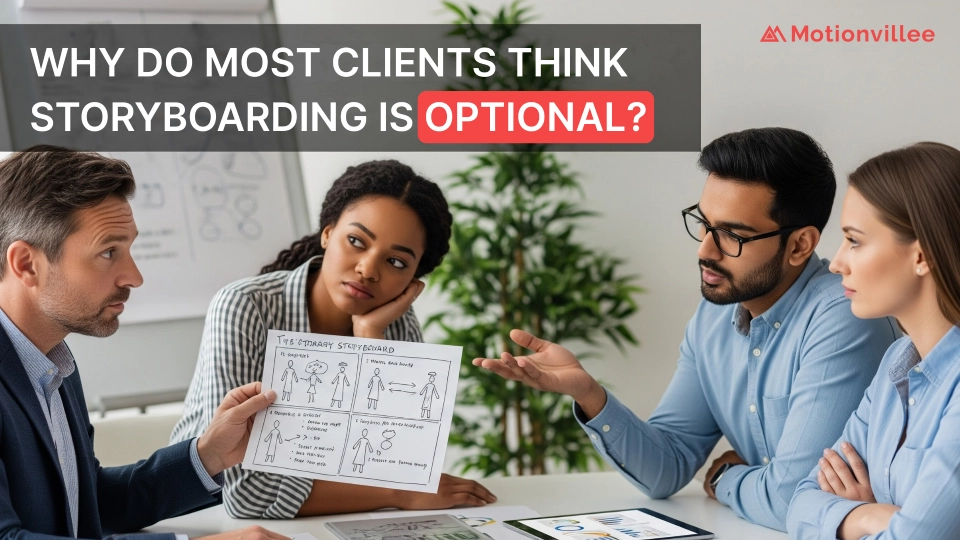
How Does Storyboarding Save Time During Production?
Storyboarding eliminates confusion on set by giving everyone a clear, shared vision, which reduces decision fatigue and speeds up shooting.
Production days are expensive. Every hour on set involves crew, equipment, locations, and talent. When your team arrives without a detailed plan, you waste those costly hours debating shot choices, discussing angles, or second guessing the creative direction. A storyboard removes that friction entirely.
Here’s how the storyboard process streamlines production:
The director knows exactly which shots to capture and in what order. The cinematographer prepares lighting and camera setups in advance. The crew understands the day’s goals and works more efficiently. Everyone moves with purpose instead of waiting for decisions.
Making creative choices on the fly sounds flexible, but it destroys video production efficiency. Each unplanned decision requires discussion, testing, and approval. This compounds across dozens of shots, turning a scheduled 8 hour day into 12 hours or requiring additional shooting days. The video production timeline stretches, costs increase, and teams get fatigued.
Real examples of time saved through storyboarding:
- Fewer takes per shot because everyone knows what success looks like
- Faster equipment setups because camera positions are pre planned
- Reduced downtime between scenes due to clear shot sequences
- Eliminated reshoots because nothing critical was missed
Video pre-production, especially storyboarding, is where you gain control over your schedule. A well executed storyboard might take a day to create but saves multiple days during filming. That’s not just faster delivery. That’s budget protection and quality assurance built into your process.
One of the most valuable storyboarding benefits is peace of mind. When production wraps, you know with certainty you captured everything needed because it was all planned and checked off systematically.
Does Storyboarding Actually Reduce Costs?
Yes, storyboarding identifies potential problems before you spend money on production, preventing expensive reshoots and reducing editing time.
Consider the cost comparison. Creating a storyboard requires design time during video pre-production, typically a few thousand dollars depending on project complexity. Skipping the storyboard and discovering problems later costs exponentially more.
What happens when you skip storyboarding:
A confusing sequence requires reshoot days at $10,000 to $20,000 per day. Missing shots force editors to spend extra hours creating workarounds, adding thousands to post production costs. Unclear messaging means multiple revision rounds as stakeholders try to fix narrative problems that should have been caught on paper.
Storyboarding prevents scope creep by defining boundaries. When clients see the visual plan upfront, they make their feedback and change requests before production starts. Changes on paper cost nothing compared to changes on set or in the editing suite.
The ROI of catching problems in the planning phase is enormous. Let’s say video production planning reveals your script requires 50 shots, but only 35 fit your budget and timeline. With a storyboard, you identify this mismatch before hiring crew or booking locations. Without one, you discover it mid production when it’s too late to adjust efficiently.
Real cost examples from productions without storyboards:
- A SaaS company paid for an extra shoot day because key product shots weren’t captured initially: $15,000
- A fintech firm spent $8,000 in editing overages trying to make disconnected footage work together
- A startup wasted $12,000 on a video that missed their target message entirely and required a complete redo
Video production cost is about more than the line items in your estimate. It’s about avoiding waste, maximizing value from every dollar spent, and delivering results that achieve your business objectives. Storyboarding ensures your money goes toward creating great content, not fixing avoidable mistakes.
One of the strongest storyboarding benefits is financial predictability. When you plan thoroughly, your budget becomes reliable instead of a starting point that balloons with changes and surprises.
How Does a Storyboard Improve Messaging and Clarity?
Storyboards force you to think through your message visually before production starts, ensuring every shot serves a purpose and your narrative flows logically.
Writing a script is only half the work. Words on a page don’t reveal how your story will translate to screen. A video storyboard makes the abstract concrete, showing you exactly how your message unfolds frame by frame. This visual planning process exposes gaps, redundancies, and missed opportunities that are invisible in text alone.
How storyboarding strengthens your storytelling:
You see whether your opening hooks attention or starts too slowly. You discover if your call to action feels natural or tacked on. You identify moments where visuals can communicate more effectively than words. This clarity improves video messaging clarity before you commit resources to filming.
Seeing the flow on paper reveals where your narrative stumbles. Maybe your product demo jumps from feature to feature without showing the user journey. Perhaps your brand video introduces too many ideas without letting any land emotionally. A storyboard surfaces these structural problems when they’re easy to fix.
Storyboards play a critical role in aligning stakeholders. When executives, marketing teams, and external partners review a visual plan together, they share the same reference point. Feedback becomes specific rather than vague. Instead of “I don’t think this will work,” you get “this transition feels abrupt” or “we need to emphasize this benefit earlier.”
The danger of skipping this step:
Without a video storyboard, you risk creating what editors call franken edits. These are videos assembled from footage that doesn’t naturally fit together. Transitions feel jarring. Pacing is inconsistent. Key messages get buried or lost entirely. You shot everything, but nothing works as a cohesive whole.
Business video production requires clarity at every stage. Your audience won’t give you multiple chances to communicate value. A confusing or unclear video damages credibility and wastes the opportunity to engage prospects. Storyboarding is how you ensure your message lands the way you intend, every single time.
One of the most underrated storyboarding benefits is confidence. When you’ve thoroughly planned your visual story, you know your video will achieve its purpose before production even begins.
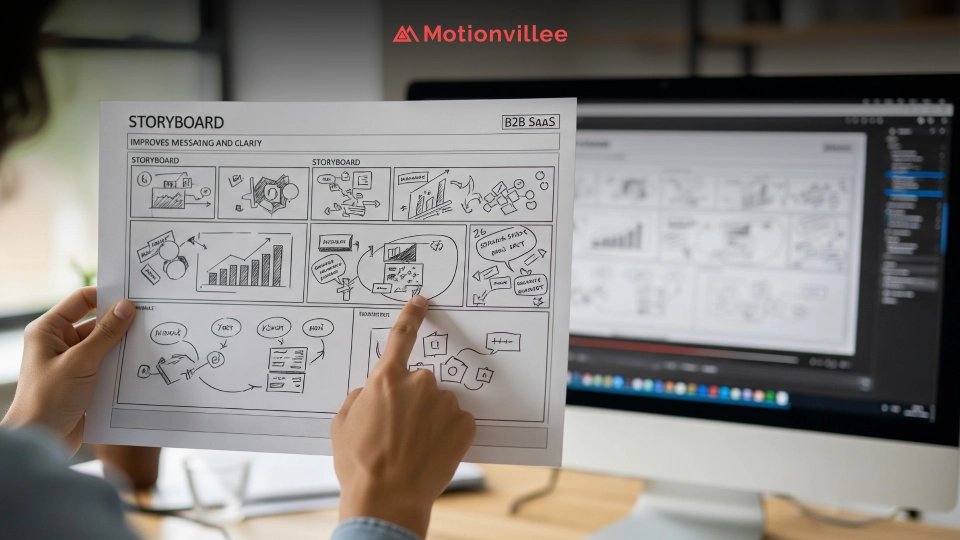
Can You Create an Effective Video Without a Storyboard?
You can create a video without a storyboard, but it’s riskier, less efficient, and often requires more time in editing to fix narrative or visual inconsistencies.
Some very simple projects might not need detailed storyboards. A basic screen recording with voiceover or a motion graphics video built from existing templates can work without frame by frame planning. These projects have minimal variables and rely on established formats.
When skipping storyboards might be acceptable:
- Simple talking head interviews with minimal b-roll
- Template based social media content with preset structures
- Quick internal communications where polish isn’t critical
- Projects with extremely limited scope and no narrative complexity
For anything beyond these scenarios, the trade offs of going without a video storyboard become significant. You’re betting that your director’s intuition will solve every creative challenge perfectly on the first try. Sometimes that works. Often it doesn’t, and the problems surface when it’s too late to fix them efficiently.
Professional video production companies always storyboard for good reason. They’ve seen what happens when projects skip this step. The video production process becomes reactive instead of proactive. Editors inherit footage that doesn’t cut together smoothly. Clients request changes that require expensive reshoots because expectations weren’t aligned upfront.
The quality difference between storyboarded versus improvised videos is measurable:
Storyboarded videos have intentional pacing, purposeful shot choices, and coherent narratives. Improvised videos often feel scattered, with uneven quality across different sections. Viewers may not consciously notice these differences, but they respond to them through engagement metrics and conversion rates.
If you’re investing serious budget into a video, skipping the storyboard to save a few days or a few thousand dollars is false economy. You’re optimizing the wrong thing. The question isn’t whether you can create something without a storyboard. It’s whether you should risk your investment and timeline on an approach that professional video production teams consider unnecessarily risky.
What Happens When Clients Skip the Storyboard Phase?
Projects without storyboards frequently experience misaligned expectations, longer revision cycles, and final videos that fail to achieve their intended business goals.
The problems start small and compound. A client approves a script imagining one visual style while the production team interprets it differently. Without a storyboard to align these visions, no one realizes the disconnect until the first cut arrives. By then, reshooting is expensive or impossible.
Common problems that emerge without video production planning:
- Wrong tone: The video feels too casual when it should be authoritative, or too corporate when it should feel accessible
- Unclear call to action: The CTA gets buried or feels disconnected from the story
- Disconnected scenes: Individual shots look fine but don’t flow into a coherent narrative
- Missing key elements: Important product features, brand messages, or proof points never made it on camera
Lack of planning leads to expensive revision requests. Clients watch the first edit and realize it doesn’t match their expectations. They ask for changes, but many are impossible without new footage. The editor tries workarounds, but these feel like patches rather than intentional creative choices. Quality suffers.
The frustration of “we didn’t get what we expected” is mutual. Clients feel disappointed and question the production team’s competence. The team feels unfairly criticized for delivering exactly what was in the approved script. Everyone loses because there was no visual reference point to ensure alignment before production started.
Real scenarios where skipping video storyboards backfired:
A cybersecurity company rushed into production with just a script. The final video emphasized features their audience didn’t care about and buried the compliance benefits that actually drive decisions. They had to start over: new script, new storyboard, new production.
A fintech startup skipped storyboarding to save time. Their video production timeline actually stretched longer because the editor needed multiple revision rounds to fix structural problems. The project took 8 weeks instead of the planned 4, and the final result still felt disjointed.
When you skip the storyboard phase, you’re not saving time or money. You’re just moving problems downstream where they’re harder and more expensive to solve. Every professional production company knows this, which is why storyboarding remains standard practice despite client pressure to skip it.
How Does Storyboarding Benefit Different Video Types?
Every video type benefits from storyboarding, but the level of detail varies based on complexity and purpose.
Product demos and explainer videos need precise storyboarding. Every shot must clearly demonstrate functionality or explain concepts visually. A storyboard for product video maps out screen recordings, callouts, animations, and transitions that guide viewers through features logically. Without this planning, product videos become confusing feature dumps instead of compelling demonstrations of value.
For explainer video production, storyboards are essential for pacing complex information. You need to know exactly when to introduce each concept, how long to spend on each point, and how visuals reinforce the narration. A storyboard for explainer video ensures nothing moves too fast or drags too long.
Storyboarding for brand videos and testimonials:
Brand videos rely on emotional flow rather than information delivery. The storyboard maps out mood, visual metaphors, and how scenes build toward your brand message. Testimonial videos need storyboards to plan b-roll that illustrates customer stories and adds visual interest to talking head footage.
Storyboarding for social media content and ads:
Short form content seems simple, but the 15 to 60 second constraint makes every frame count. Storyboards help you maximize impact in minimal time, ensuring your hook grabs attention in the first 3 seconds and your message lands before viewers scroll past.
Storyboard examples vary widely based on project type. A corporate training video might use simple thumbnail sketches focused on instructional clarity. A high end brand film might have detailed, artistically rendered frames that capture specific lighting and composition. The format matters less than the function: giving everyone a shared vision.
Adapting storyboard detail to project complexity:
- Simple projects: Basic thumbnail sketches with notes
- Standard business video production: Frame by frame drawings with shot descriptions
- Complex productions: Detailed illustrations, color scripts, and technical specifications
The consistency across all these applications is that storyboarding improves outcomes. Whether you’re explaining software features, building brand emotion, or driving social engagement, planning your visual story before production starts is how professionals deliver quality results on time and on budget.
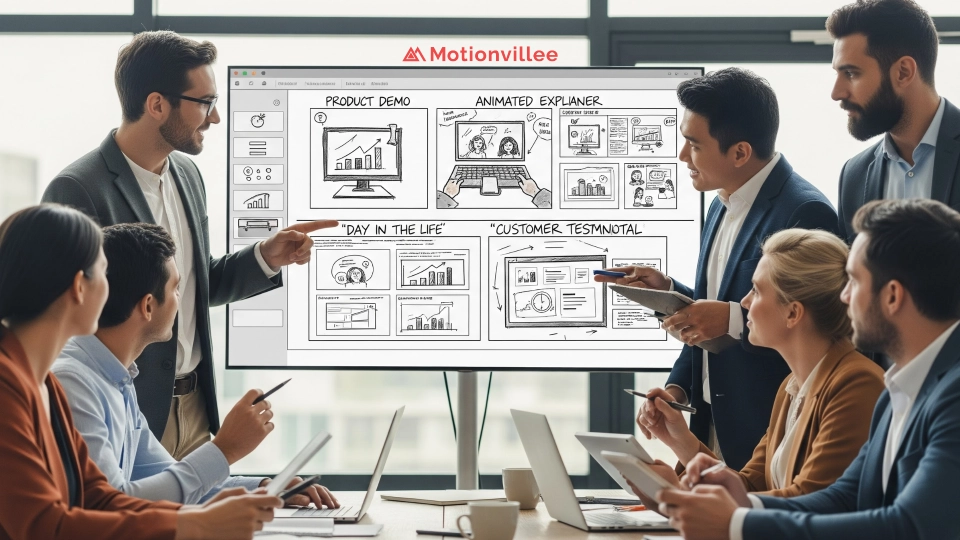
Why Does Motionvillee Storyboard Even When Clients Don’t Request It?
We storyboard every project because it’s the only way to guarantee your video meets your goals, stays on budget, and delivers the ROI you expect.
At Motionvillee, storyboard video production isn’t an upsell or an optional service. It’s built into our process for every project, regardless of whether clients specifically request it. This commitment stems from years of experience seeing what separates successful videos from disappointing ones. The difference almost always comes down to planning.
Our approach to quality and video production efficiency:
We treat storyboarding as client protection, not just creative preference. When we create a detailed visual plan before production starts, we eliminate surprises, prevent costly mistakes, and ensure everyone shares the same vision. This protects your investment and timeline while giving you control over the final product before resources are committed.
Internal storyboarding serves multiple functions. It forces our team to thoroughly think through every creative decision. It creates a reference tool that keeps production organized and focused. It provides clients with a clear approval checkpoint where changes are easy and inexpensive.
The difference between vendors and partners:
Vendors do what you ask and bill for their time. Partners do what produces results, even if it requires extra steps you didn’t know to request. Skipping storyboards might make our sales process easier in the short term. We could close deals faster by eliminating a review stage. But that approach prioritizes our convenience over your success.
We’ve seen too many projects fail or underperform because corners were cut during planning. A business video production that misses its messaging goals isn’t just a wasted expense. It’s a missed opportunity to drive pipeline, build brand trust, or educate your market. Those failures have real business consequences.
Why this approach builds lasting client relationships:
When clients work with production companies that storyboard thoroughly, they experience fewer surprises, smoother projects, and better final results. They trust the process because they’ve seen the protection it provides. They understand that professional video production requires professional planning.
Our commitment to storyboarding is really a commitment to your success. We want every video we produce to deliver measurable value for your business. That only happens when we plan thoroughly, execute precisely, and deliver exactly what we promised. Video production efficiency comes from doing things right, not doing things fast.
Storyboarding Is Strategy, Not Extra Steps
Storyboard video production transforms video from a creative gamble into a strategic investment with predictable outcomes.
The evidence is clear across every section of this post. Storyboarding saves time by eliminating on set confusion. It reduces costs by catching problems before production. It improves messaging by forcing visual thinking during planning. It prevents the frustration of misaligned expectations and expensive revision cycles.
Skipping this step creates avoidable risks that undermine your video’s effectiveness and waste your budget. You might save a few days in the planning phase, but you’ll lose weeks in extended production, editing, and revisions. More importantly, you risk launching a video that fails to achieve your business goals.
Storyboarding is a strategic advantage:
Companies that understand this produce better videos faster and more efficiently. They protect their investments by planning thoroughly. They align their teams around shared visions instead of discovering disconnects after it’s too late to fix them affordably.
The question isn’t whether storyboarding adds value. Professional video production companies resolved that debate decades ago. The question is whether you’ll insist on working with partners who prioritize your success through proper planning, or settle for vendors who cut corners and hope problems don’t emerge.
Ready to produce a video that delivers real business results? Schedule a call with Motionvillee to discuss your next project. We’ll walk you through our process and show you exactly how thorough planning translates to videos that drive pipeline, build trust, and achieve your goals.


